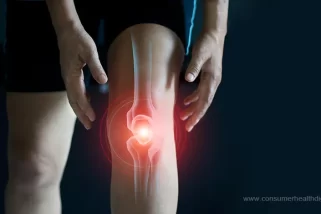What Are Non-steroidal Anti-inflammatory Drugs (NSAIDs)?
Non-steroidal anti-inflammatory drugs are drugs that are used to reduce inflammation without the harmful side effects of steroid drugs. NSAIDs are medicines that stop a special enzyme called cyclooxygenase, which the body uses to create something called prostaglandins. When you take NSAIDs, they reduce the amount of prostaglandins made in your body.[1]

NSAIDs are not just for inflammation. They can also help with other things like headaches, period cramps, pain after surgery, and lowering a fever. People often use non-steroidal anti-inflammatory drugs (NSAIDs) to help with the pain and swelling that come with arthritis and similar muscle and joint problems.
What are the types of NSAIDs?
NSAIDs can be both selective and non-selective. Non-selective NSAIDs like aspirin block both the variants of the enzymes hence stops pain, fever, and inflammation but can damage the stomach lining causing ulcers and blood-thinning side effects.
Selective NSAIDs like Celebrex, are medicines that help with pain and inflammation.[2] They work well and are less likely to hurt your stomach compared to regular NSAIDs. People who’ve had stomach problems with regular NSAIDs might be advised to use selective ones. Selective NSAIDs are safer for the stomach because they don’t cause as many ulcers or bleeding.
Exploring Common NSAID Drugs: What Scientific Research Can We Uncover?
In this part, we’ll take a closer look at different types of medications known as Nonsteroidal Anti-Inflammatory Drugs (NSAIDs). We’ll explore what they are, how they’re used, how they work, and discuss how effective they are in treating various conditions. Each of these drugs has its own special qualities that make them good for different health issues. We’ll also give you an honest view of their possible advantages, and we’ll stress why it’s crucial to talk to a healthcare expert to decide which one is best for your particular needs. Now, let’s get into the nitty-gritty of each of these NSAID drugs.
- Aspirin:
- Ibuprofen:
- Naproxen:
- Diclofenac:
- Celecoxib:
- Mefenamic acid:
- Etoricoxib:
- Indomethacin:
- Headaches
- Cough and colds
- Arthritis
- Menstrual cramps
- Indigestion, which may cause stomach aches, feeling nauseous, or diarrhea.
- Stomach ulcers can lead to internal bleeding and anemia; your doctor may prescribe additional medicine to protect your stomach.
- Headaches
- Drowsiness
- Dizziness
- Allergic reactions
Type: Aspirin is an acetylated salicylate NSAID.
Uses: It is used for pain relief, inflammation reduction, fever reduction, and even lowering the risk of cardiovascular events.
Mechanism: Aspirin inhibits the COX enzyme and blocks prostaglandin production.[3]
Scientific Insight: An article published in Clinical Medicine and Research found that Aspirin helps with pain, but it can also have some drawbacks like causing stomach bleeding and other problems.[4]
Type: Ibuprofen falls under the category of propionic acid NSAIDs.
Uses: It is commonly used to manage pain, reduce fever, and alleviate inflammation.
Effectiveness: Scientific studies have demonstrated its higher antipyretic effectiveness compared to paracetamol.
Mechanism: Ibuprofen works by inhibiting prostaglandin production.[5]
Scientific Insights: An article published by Vincent Trung H. on Ibuprofen in the National Institute of Health found that it is used to treat conditions like inflammation, certain types of arthritis, mild to moderate pain, fevers, menstrual cramps, and osteoarthritis.[6]
Type: Naproxen is another propionic acid NSAID.
Uses: It is used for pain relief, fever reduction, and inflammation reduction.
Mechanism: Similar to other NSAIDs, it inhibits prostaglandin production.
Clinical Application: Naproxen finds utility in acute treatment, including conditions like acute migraines and cluster headaches.[7]
Scientific Insights: An article published by Europe PMC Central Journal found that taking either 200 mg of naproxen or 220 mg of naproxen sodium can help relieve pain after surgery.[8]
Type: Diclofenac belongs to the acetic acid NSAID category.
Uses: It is used for pain relief, fever reduction, inflammation reduction, and for specific soft tissue injuries.
Form: Diclofenac is available in topical gel form, which can be useful for targeted applications.
Mechanism: Its mechanism involves the inhibition of prostaglandin production.[9]
Scientific Insights: A research study published in the Reumatologia Journal suggested that taking 150 mg of diclofenac each day is the best way to treat pain in people with rheumatic diseases.[10]
Type: Celecoxib is a selective COX-2 inhibitor NSAID.
Uses: It offers pain relief, fever reduction, and inflammation reduction.
Mechanism: Celecoxib selectively inhibits the COX-2 enzyme.[11]
Scientific Insights: A scientific study published in the Experimental and Therapeutic Medicine Journal found that Celecoxib can help reduce pain after surgery, improve how you feel, and help you move better during recovery. It can also reduce the need for strong painkillers.[12]
Type: Mefenamic acid falls under the anthranilic acid NSAID category.
Uses: It is used for pain relief, fever reduction, and inflammation reduction.
Mechanism: Mefenamic acid works by inhibiting prostaglandin production.[13]
Scientific Insights: An article published in the Oral Surgery, Oral Medicine, Oral Pathology Journal suggested that Mefenamic acid works well for managing pain after getting an impacted molar removed.[14]
Type: Etoricoxib is another selective COX-2 inhibitor NSAID.
Uses: It is used for pain relief, fever reduction, and inflammation reduction.
Mechanism: Etoricoxib selectively inhibits the COX-2 enzyme.[15]
Scientific Insights: A research study published in BJBMS Journal found that Etoricoxib makes things better for really old people with osteoarthritis. It helps with pain, makes their joints work better, and improves their overall quality of life.[16]
Dosage:
Type: Indomethacin is categorized as an acetic acid NSAID.
Uses: It is used for pain relief, fever reduction, and inflammation reduction.
Mechanism: Indomethacin works by inhibiting prostaglandin production.[17]
Scientific Insights: In an article published by Taylor and Francis Journal, it was found that doctors often give Indomethacin to ease the pain of gouty arthritis and it has been shown to work well for treating other painful conditions too.[18]
What do we suggest?
The choice of the best NSAID depends on individual needs and medical conditions. Aspirin offers a wide range of benefits but may pose a risk of stomach bleeding. Ibuprofen is highly effective for pain and inflammation. Naproxen is valuable for acute pain relief. Diclofenac’s topical form is useful for targeted relief, and selective COX-2 inhibitors like celecoxib can be beneficial post-surgery. Mefenamic acid helps after dental procedures, etoricoxib aids elderly individuals with osteoarthritis, and indomethacin is commonly used for gouty arthritis. However, the optimal NSAID choice varies by individual, so we would strongly advise consulting a healthcare professional for personalized advice before you consume any NSAID drugs.
User Experience with NSAIDs
In the upcoming sections, we delve into the real-life experiences of individuals using NSAIDs, particularly for arthritis. We’ll discuss the prevalence of NSAID use and the related gastrointestinal side effects, along with solutions like proton pump inhibitors. We’ll also examine demographics at higher risk for NSAID-induced ulcers, explore the use of multiple NSAIDs, and consider patient outcomes, emphasizing age and other factors. Additionally, we’ll briefly touch on alternative options like joint pain supplements such as Omega XL.
According to the American College of Gastroenterology estimates that 14 million arthritis patients use NSAIDs continuously. 80% of NSAID users complained of gastrointestinal side effects like stomach pain and ulcers. However, adding a proton pump inhibitor can help with these problems. Those most at risk for NSAID-induced ulcers are the elderly, smokers, alcoholics, and people who use multiple NSAIDs.[19]
The efficiency of the use of multiple NSAIDs has not been established as well.[20] The patient’s ability to heal from ulcers or internal bleeding depends on age and other relevant factors. 1-2% of people on NSAIDs do develop a frightening ulcer complication, however, according to the American College of Gastroenterology, around 10 percent of continuous NSAID users quit their medication because of troublesome gastrointestinal side effects.
You can also choose joint pain supplements which are very trending nowadays and come at a very fair price. You might consider Omega XL, which is the most reviewed pain supplement today. It is designed specially to target the root cause of joint pain to eliminate it altogether.
NSAID use highlights a significant incidence of gastrointestinal side effects, particularly in arthritis patients. Proton pump inhibitors show promise in mitigating these issues, while specific groups, like the elderly, smokers, alcohol consumers, and those using multiple NSAIDs, face a higher risk of NSAID-induced ulcers. Patient healing outcomes from ulcers or bleeding depend on factors like age and individual health conditions. Informed healthcare decisions, including potential alternatives like joint pain supplements, are essential for effective pain relief while considering possible side effects.
Benefits of NSAID Drugs
NSAIDs are beneficial because they can help with fever,[21] pain, and inflammation, which makes them valuable for conditions such as:
Possible Side Effects:
NSAIDs are known to cause side-effects such as
In rare cases, NSAIDs may lead to more severe issues involving your liver, kidneys, heart, and circulation, such as heart failure, heart attacks, and strokes. If you experience bothersome side effects, it’s essential to stop taking the medicine and consult your doctor for guidance.
21 Sources
We review published medical research in respected scientific journals to arrive at our conclusions about a product or health topic. This ensures the highest standard of scientific accuracy.
[2] Efficacy and Safety of Celecoxib Therapy in Osteoarthritis: https://www.ncbi.nlm.nih.gov/pmc/articles/PMC4902402/
[3] COX Inhibitors: https://www.ncbi.nlm.nih.gov/books/NBK549795/
[4] An Evidence-Based Update on Nonsteroidal Anti-Inflammatory Drugs: https://www.ncbi.nlm.nih.gov/pmc/articles/PMC1855338/
[5] PharmGKB summary: ibuprofen pathways: https://www.ncbi.nlm.nih.gov/pmc/articles/PMC4355401/
[6] Ibuprofen: https://www.ncbi.nlm.nih.gov/books/NBK542299/
[7] Gastric Irritation Effect of COX Inhibitors vs. NSAIDs: https://www.aafp.org/pubs/afp/issues/2000/0301/p1472.html
[8] Single dose oral naproxen and naproxen sodium for acute postoperative pain: https://www.ncbi.nlm.nih.gov/pmc/articles/PMC4164452/
[9] Topical Diclofenac, an Efficacious Treatment for Osteoarthritis: A Narrative Review: https://www.ncbi.nlm.nih.gov/pmc/articles/PMC7211216/
[10] Diclofenac in the treatment of pain in patients with rheumatic diseases: https://www.ncbi.nlm.nih.gov/pmc/articles/PMC6052370/
[11] Selective COX-2 Inhibitors: A Review of Their Structure-Activity Relationships: https://www.ncbi.nlm.nih.gov/pmc/articles/PMC3813081/
[12] Efficacy of celecoxib for acute pain management following total hip arthroplasty in elderly patients: : https://www.spandidos-publications.com/10.3892/etm.2015.2512
[13] Mefenamic Acid: https://www.ncbi.nlm.nih.gov/books/NBK548029/
[14] Control of pain by mefenamic acid following removal of impacted molar: https://www.sciencedirect.com/science/article/abs/pii/S0030422081800023
[15] Cardiovascular and gastrointestinal effects of COX-2 inhibitors and NSAIDs: https://arthritis-research.biomedcentral.com/articles/10.1186/ar1794
[16] Etoricoxib improves osteoarthritis pain relief, joint function, and quality of life in the extreme elderly: https://www.ncbi.nlm.nih.gov/pmc/articles/PMC5826680/
[17] Indomethacin: https://medlineplus.gov/druginfo/meds/a681027.html
[18] Role of Indomethacin in Acute Pain and Inflammation Management: https://www.tandfonline.com/doi/abs/10.3810/pgm.2014.07.2787
[19] The use of proton pump inhibitors in treating and preventing NSAID-induced mucosal damage: https://arthritis-research.biomedcentral.com/articles/10.1186/ar4177
[20] Safe prescribing of non-steroidal anti-inflammatory drugs in patients with osteoarthritis: https://bmcmedicine.biomedcentral.com/articles/10.1186/s12916-015-0285-8
[21] NSAIDs: https://www.nhs.uk/conditions/nsaids/








 This article changed my life!
This article changed my life! This article was informative.
This article was informative. I have a medical question.
I have a medical question.
 This article contains incorrect information.
This article contains incorrect information. This article doesn’t have the information I’m looking for.
This article doesn’t have the information I’m looking for.